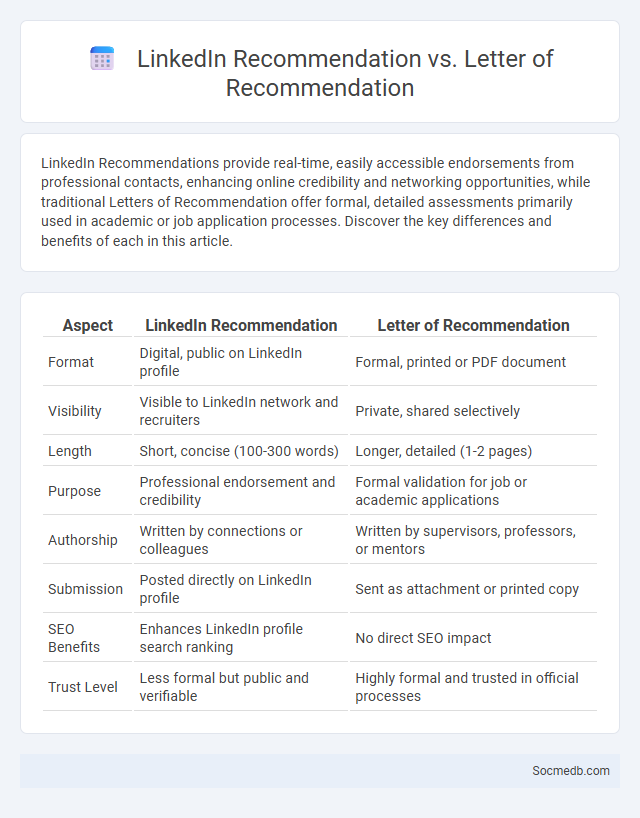
Photo illustration: LinkedIn Recommendation vs Letter of Recommendation
LinkedIn Recommendations provide real-time, easily accessible endorsements from professional contacts, enhancing online credibility and networking opportunities, while traditional Letters of Recommendation offer formal, detailed assessments primarily used in academic or job application processes. Discover the key differences and benefits of each in this article.
Table of Comparison
| Aspect | LinkedIn Recommendation | Letter of Recommendation |
|---|---|---|
| Format | Digital, public on LinkedIn profile | Formal, printed or PDF document |
| Visibility | Visible to LinkedIn network and recruiters | Private, shared selectively |
| Length | Short, concise (100-300 words) | Longer, detailed (1-2 pages) |
| Purpose | Professional endorsement and credibility | Formal validation for job or academic applications |
| Authorship | Written by connections or colleagues | Written by supervisors, professors, or mentors |
| Submission | Posted directly on LinkedIn profile | Sent as attachment or printed copy |
| SEO Benefits | Enhances LinkedIn profile search ranking | No direct SEO impact |
| Trust Level | Less formal but public and verifiable | Highly formal and trusted in official processes |
Introduction to Professional Recommendations
Professional recommendations on social media enhance credibility by showcasing verified endorsements from colleagues and industry experts. Platforms like LinkedIn utilize recommendation features that highlight skills, work ethic, and achievements, which boost professional profiles and hiring potential. Authentic and detailed recommendations contribute to building trust and expanding networking opportunities within relevant professional communities.
What is a LinkedIn Recommendation?
A LinkedIn Recommendation is a written endorsement from a colleague, client, or manager that highlights your professional skills, work ethic, and achievements on your LinkedIn profile. It enhances your credibility by providing authentic testimonials that boost your personal brand and attract potential employers or business partners. You can request and display these recommendations to showcase your strengths and build trust within your professional network.
Understanding Traditional Letters of Recommendation
Traditional letters of recommendation serve as formal endorsements from trusted sources, highlighting an individual's skills, achievements, and character to support applications or opportunities. These letters often provide personalized insights and credible validation, which can be more impactful than generic social media endorsements. Understanding the distinct role of these letters helps in leveraging both authentic personal testimonials and digital reputations effectively.
Defining General Recommendations
Effective use of social media involves defining general recommendations that enhance engagement and brand visibility. Best practices include regular content scheduling, audience targeting based on demographics and interests, and maintaining consistent brand messaging across platforms. Employing analytics tools to track performance and adapting strategies accordingly ensures optimal reach and interaction.
Format Differences: LinkedIn vs Letter vs General
LinkedIn emphasizes professional, concise content with bullet points and headlines that enhance readability and engagement, while letters prioritize formal structure, personalized salutations, and detailed narratives suited for one-on-one communication. General social media formats favor informal language, multimedia integration like images and videos, and brevity to capture quick attention in diverse audiences. Your choice of format should align with the platform's user expectations to maximize message clarity and impact.
Visibility and Accessibility of Each Recommendation Type
Social media platforms enhance visibility by tailoring content distribution algorithms to amplify posts based on user engagement metrics like shares, likes, and comments, ensuring recommendations reach broader audiences. Accessibility of recommendation types varies as visual content such as images and videos provides instant appeal while text-based suggestions enable deeper information delivery through captions and comments. Personalized recommendations leverage user data to present relevant content, improving discoverability across feeds and stories, which boosts interaction rates and platform retention.
Impact on Job Applications and Networking
Social media platforms play a crucial role in shaping your job applications and networking opportunities by showcasing your professional brand and skills to potential employers. Recruiters increasingly use platforms like LinkedIn to verify qualifications and assess candidates' cultural fit through your online presence. Engaging in industry-specific groups and sharing relevant content can significantly expand your professional network and increase your chances of landing job offers.
Key Benefits and Drawbacks of Each Approach
Social media platforms offer distinct benefits: Facebook excels in community building and detailed demographic targeting, Instagram drives visual engagement and brand awareness, while LinkedIn is optimal for professional networking and B2B marketing. However, Facebook's algorithm changes can reduce organic reach, Instagram's emphasis on visuals may limit content diversity, and LinkedIn often demands higher content quality and professionalism to gain traction. Understanding these strengths and limitations enables tailored strategies that maximize audience engagement and ROI on each platform.
Choosing the Right Recommendation for Your Goals
Selecting the right social media recommendation depends on analyzing your specific goals, target audience, and platform strengths to maximize engagement and ROI. Tailoring content strategies based on user behavior data and algorithm preferences ensures your message reaches the most relevant viewers. Optimize your campaigns by prioritizing platforms aligned with your brand's objectives and performance metrics to achieve measurable growth.
Best Practices for Requesting and Giving Recommendations
When requesting recommendations on social media, personalize your message by specifying the skills or experiences you want highlighted to ensure relevant and impactful feedback. Offering recommendations requires honesty and specific examples of the person's strengths and accomplishments, which builds credibility and trust among your network. Engaging proactively by endorsing others encourages reciprocity and strengthens professional relationships, enhancing your profile's visibility and reputation.
 socmedb.com
socmedb.com